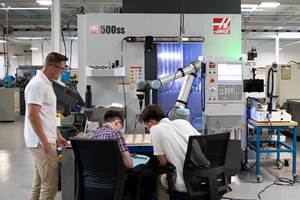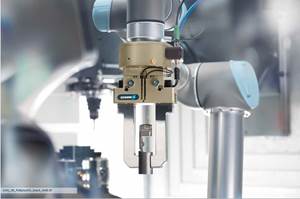EDM vs. Milling In Die/Mold Machining
In many die and mold shops, the choice between ram EDM and CNC milling is far less clear than it used to be. Changing technology is changing the rules.
Share





In many die and mold shops, the choice between ram EDM and CNC milling is far less clear than it used to be. Changing technology is changing the rules.
Milling, for example, can now be applied more broadly than ever before. Machining centers capable of following precise, complex tool paths at high feed rates have made it cost-effective for shops to use fast, light milling as an alternative to EDM in many applications involving hard metal, intricate detail and smooth finishes.
However, EDM technology has gotten better, too.
One company with a perspective on how these processes compare is Makino (Mason, Ohio), a builder offering machining centers and EDM machines both. Billy Grobe is die/mold operations manager for this builder, and he often advises customers as to which metal removal process makes sense for their work. There are no black-and-white answers, he says. However, there are rules of thumb, and the lists below summarize some of those general rules as Makino sees them today.
Mr. Grobe stresses that the comparison presented here is not between EDM and milling in general. Instead, the comparison is between EDM and what he calls “high performance” milling, which uses a machine tool and a control system both designed for complex, precise, high-feed-rate milling. With that stipulation in mind, here is where he says each process tends to make sense:
When To Use EDM
- For sharp inside corners. Until the square end mill is perfected, he says, EDM will remain the superior process for internal corners.
- For the most complex geometry. In particular, EDM makes sense when the complex surface is difficult for a milling cutter to reach.
- Where deep cutting is required. More specifically, avoid milling where the L:D (tool length to diameter ratio) is particularly high.
- In unattended cutting. EDM is the easier process to automate because it’s more predictable than milling. In a process that uses robots for loading electrodes and workpieces, a complete EDM process including electrode production can run around the clock effectively with minimal human attention.
- For high-expertise parts. In general, programming time is shorter for milling an electrode than for milling the form in metal. And in more sophisticated milling applications, the difference becomes even more pronounced. The programming time required to let the machining center do work once considered “EDM only” may be high enough that EDM remains the expedient choice.
- Where EDM finish is specified. The surface quality EDM can deliver today is better than ever. Advances related to additives, for example, not only improve the finish a graphite electrode can achieve, they also result in a shallower HAZ (heat-affected zone).
When To Use Milling
- Whenever you can, Mr. Grobe says.
- For non-cosmetic surfaces, and for surfaces to be textured. In texturing, EDM adds an extra step. Unlike a milled surface, the EDMed surface generally requires polishing before texturing can occur.
- When access is easy. If the geometry is open and L:D is low, mill away.
- For family parts. Groups of similar workpieces and multi-cavity tools both present the opportunity to amortize time spent on programming, including the time spent on learning the best way to mill the form in metal.
- For parts that cannot have a HAZ.
- Where high accuracy is required. Milling can make tight tolerances easier to hold. In EDM, tolerance stacking comes from machining the electrode, changing holders and using multiple electrodes on the same part. Also, EDM accuracy declines as finer surface finish is approached. But milling entails less tolerance stacking and makes no accuracy-versus-finish tradeoff.
- When EDM operators are in short supply. In many shops, personnel considerations will take precedent over considerations related to the technology.
And there are still more considerations beyond these, Mr. Grobe says. One very basic one is Which machine is open? A related factor is the availability of programming resources.
In fact, the influence of the programming step points to another consideration important in comparing EDM vs. milling, or any competing processes. Whatever the process in question, an accurate assessment of how efficient it can be will only come from looking at the process as a whole, not just the machine tool. The true measure of the machine's potential effectiveness will come only when all of the steps preceding the machine have been evaluated to ensure that they, too, are working as efficiently as possible.
Related Content
Orthopedic Event Discusses Manufacturing Strategies
At the seminar, representatives from multiple companies discussed strategies for making orthopedic devices accurately and efficiently.
Read MoreCNC Machine Shop Honored for Automation, Machine Monitoring
From cobots to machine monitoring, this Top Shop honoree shows that machining technology is about more than the machine tool.
Read MoreLean Approach to Automated Machine Tending Delivers Quicker Paths to Success
Almost any shop can automate at least some of its production, even in low-volume, high-mix applications. The key to getting started is finding the simplest solutions that fit your requirements. It helps to work with an automation partner that understands your needs.
Read MoreQuick-Change Tool Heads Reduce Setup on Swiss-Type Turning Centers
This new quick-change tooling system enables shops to get more production from their Swiss turning centers through reduced tool setup time and matches the performance of a solid tool.
Read MoreRead Next
Machine Shop MBA
Making Chips and 91ÊÓƵÍøÕ¾ÎÛ are teaming up for a new podcast series called Machine Shop MBA—designed to help manufacturers measure their success against the industry’s best. Through the lens of the Top Shops benchmarking program, the series explores the KPIs that set high-performing shops apart, from machine utilization and first-pass yield to employee engagement and revenue per employee.
Read MoreAMRs Are Moving Into Manufacturing: 4 Considerations for Implementation
AMRs can provide a flexible, easy-to-use automation platform so long as manufacturers choose a suitable task and prepare their facilities.
Read MoreLast Chance! 2025 Top Shops Benchmarking Survey Still Open Through April 30
Don’t miss out! 91ÊÓƵÍøÕ¾ÎÛ's Top Shops Benchmarking Survey is still open — but not for long. This is your last chance to a receive free, customized benchmarking report that includes actionable feedback across several shopfloor and business metrics.
Read More






















